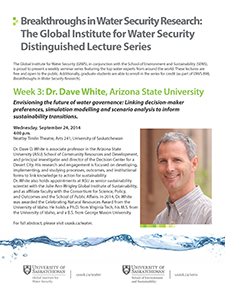Dave White was invited to speak as a distinguished lecturer at the University of Saskatchewan’s Breakthroughs in Water Security Research: The Global Institute for Water Security Distinguished Lecture Series on Wednesday, September 24, 2014.
Date: Wednesday, September 24, 2014
Time: 3:00pm in Arizona
Location: Neatby-Timlin Theatre, Arts 241, University of Saskatchewan
View the lecture: http://www.youtube.com/watch?v=TAwyv3KhAjQ
Lecture Title
Envisioning the future of water governance: Linking decision-maker preferences, simulation modelling and scenario analysis to inform sustainability transitions.”
Talk Abstract
The coupled effects of global climate change and population dynamics on water systems are widely considered to be among the greatest urban sustainability challenges facing humanity in the Anthropocene. Climate change impacts, including rising temperatures, changes in the amount and timing of local precipitation, and increased variability will very likely reduce renewable surface and groundwater supplies and diminish raw water quality, leading to widespread but uneven risks. Semiarid and arid regions will be particularly vulnerable. Meanwhile, the world’s urban population is projected to double in the next generation and much of this urban growth will occur in arid or semiarid environments. Climate impacts will amplify existing vulnerabilities in water-scare urban regions associated with inherent variability, cyclical drought, and extreme heat. Furthermore, the projected biophysical impacts of climate change are conditioned by and interact with land use changes, population dynamics, economic development, and water management decisions. Indeed, the non-climatic stressors on water resources may outweigh the climate impacts for some regions. Taken together, these interrelated pressures pose unprecedented challenges for urban sustainability. To address these challenges, there are growing number of scholars, policy-makers, and interest groups calling for transformational solutions to enable a transition towards urban water sustainability. An essential task for such transitions is to envision a sustainable future for water governance.
He will highlight recent research that utilizes a participatory, mixed-method approach, including survey questionnaire, scenario analysis, and simulation modeling, to construct distinct, coherent, plausible, and desirable governance scenarios of the Phoenix, Arizona USA region in 2030. Four scenarios provide stakeholders and policy makers with distinct options for future water governance regimes, while the approach integrates normative values and preferences with dynamic models to inform sustainable policy making. The first scenario, Technical Management for Megapolitan Development, based on the stakeholder survey, describes a future in which water experts negotiate and acquire more water so Phoenix can continue to grow. The second scenario, Citizen Councils Pursue Comprehensive Sustainability, was selected using the sustainability appraisal. This scenario describes a future where watershed-like councils use policy instruments to reduce water use as part of a comprehensive approach to sustainability that includes integrated policy making for water, energy, food, and urban planning. Experts Manage Limited Water for Unlimited Growth is the third scenario, selected using plausibility indications, and describes a future where water experts struggle to provide for a growing population without restricting water use or acquiring new water sources. Water governance reflects a classic “muddling through” approach. The final scenario, Collaborative Governance Prioritizes Local Water Security, selected using the water security governance analysis, is a future in which water is very central to decision making. In this scenario, committees of water managers, scientists and citizens collaborate to secure water and reduce consumption to ensure the long-term viability of the metropolitan region.
Each of the four scenarios was input into WaterSim 5.0 to determine their systemic impacts under different climate scenarios. The suite of models resulted in 270 separate model runs for the 75 year simulation period for each of the 33 water utilities and the four constructed synthetic scenarios plus one base scenario.
Our approach then allows for normative scenarios to interface with a dynamic simulation model, which during stakeholder engagement activities can provide feedback to participants on the impacts of their priorities, particularly on the availability of surface and groundwater for future generations and the distribution of burdens and benefits of water and water governance. Stakeholders can then modify or dictate preconditions for their priorities and, if necessary, select new scenarios. This type of iteration and feedback with differing levels of stakeholder involvement is critical in transdisciplinary research generally and for participatory scenarios that inform transitions in particular.
The scenarios in this study can be considered boundary objects, which allow for knowledge exchange between different actors related to their opinions, values, and preferences regarding all or parts of the water system. In this capacity, the scenarios present different water governance regimes with different power arrangements in a way that is comprehensible to broad audiences. For the Phoenix region, the scenarios can also facilitate conversations with other regions about water governance. Bounding the governance regime to the Phoenix region is a necessity of the scenario construction process that does not necessarily reflect the governance or hydrological reality. In the future, Phoenix will be negotiating for water with other state and regional actors, particularly those with rights to the Colorado River. By selecting a scenario to guide transition activities, Phoenix will have a boundary object with which to communicate its priorities to its partners on the Colorado River. Such efforts could contribute to further coordination of sustainable water governance across the Southwest.


